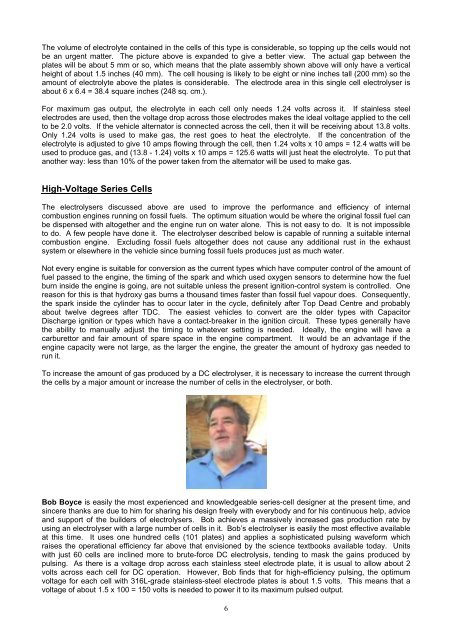Electrolyser designs - Free Energy Info
Electrolyser designs - Free Energy Info
Electrolyser designs - Free Energy Info
- No tags were found...
Create successful ePaper yourself
Turn your PDF publications into a flip-book with our unique Google optimized e-Paper software.
The volume of electrolyte contained in the cells of this type is considerable, so topping up the cells would notbe an urgent matter. The picture above is expanded to give a better view. The actual gap between theplates will be about 5 mm or so, which means that the plate assembly shown above will only have a verticalheight of about 1.5 inches (40 mm). The cell housing is likely to be eight or nine inches tall (200 mm) so theamount of electrolyte above the plates is considerable. The electrode area in this single cell electrolyser isabout 6 x 6.4 = 38.4 square inches (248 sq. cm.).For maximum gas output, the electrolyte in each cell only needs 1.24 volts across it. If stainless steelelectrodes are used, then the voltage drop across those electrodes makes the ideal voltage applied to the cellto be 2.0 volts. If the vehicle alternator is connected across the cell, then it will be receiving about 13.8 volts.Only 1.24 volts is used to make gas, the rest goes to heat the electrolyte. If the concentration of theelectrolyte is adjusted to give 10 amps flowing through the cell, then 1.24 volts x 10 amps = 12.4 watts will beused to produce gas, and (13.8 - 1.24) volts x 10 amps = 125.6 watts will just heat the electrolyte. To put thatanother way: less than 10% of the power taken from the alternator will be used to make gas.High-Voltage Series CellsThe electrolysers discussed above are used to improve the performance and efficiency of internalcombustion engines running on fossil fuels. The optimum situation would be where the original fossil fuel canbe dispensed with altogether and the engine run on water alone. This is not easy to do. It is not impossibleto do. A few people have done it. The electrolyser described below is capable of running a suitable internalcombustion engine. Excluding fossil fuels altogether does not cause any additional rust in the exhaustsystem or elsewhere in the vehicle since burning fossil fuels produces just as much water.Not every engine is suitable for conversion as the current types which have computer control of the amount offuel passed to the engine, the timing of the spark and which used oxygen sensors to determine how the fuelburn inside the engine is going, are not suitable unless the present ignition-control system is controlled. Onereason for this is that hydroxy gas burns a thousand times faster than fossil fuel vapour does. Consequently,the spark inside the cylinder has to occur later in the cycle, definitely after Top Dead Centre and probablyabout twelve degrees after TDC. The easiest vehicles to convert are the older types with CapacitorDischarge ignition or types which have a contact-breaker in the ignition circuit. These types generally havethe ability to manually adjust the timing to whatever setting is needed. Ideally, the engine will have acarburettor and fair amount of spare space in the engine compartment. It would be an advantage if theengine capacity were not large, as the larger the engine, the greater the amount of hydroxy gas needed torun it.To increase the amount of gas produced by a DC electrolyser, it is necessary to increase the current throughthe cells by a major amount or increase the number of cells in the electrolyser, or both.Bob Boyce is easily the most experienced and knowledgeable series-cell designer at the present time, andsincere thanks are due to him for sharing his design freely with everybody and for his continuous help, adviceand support of the builders of electrolysers. Bob achieves a massively increased gas production rate byusing an electrolyser with a large number of cells in it. Bob’s electrolyser is easily the most effective availableat this time. It uses one hundred cells (101 plates) and applies a sophisticated pulsing waveform whichraises the operational efficiency far above that envisioned by the science textbooks available today. Unitswith just 60 cells are inclined more to brute-force DC electrolysis, tending to mask the gains produced bypulsing. As there is a voltage drop across each stainless steel electrode plate, it is usual to allow about 2volts across each cell for DC operation. However, Bob finds that for high-efficiency pulsing, the optimumvoltage for each cell with 316L-grade stainless-steel electrode plates is about 1.5 volts. This means that avoltage of about 1.5 x 100 = 150 volts is needed to power it to its maximum pulsed output.6
















